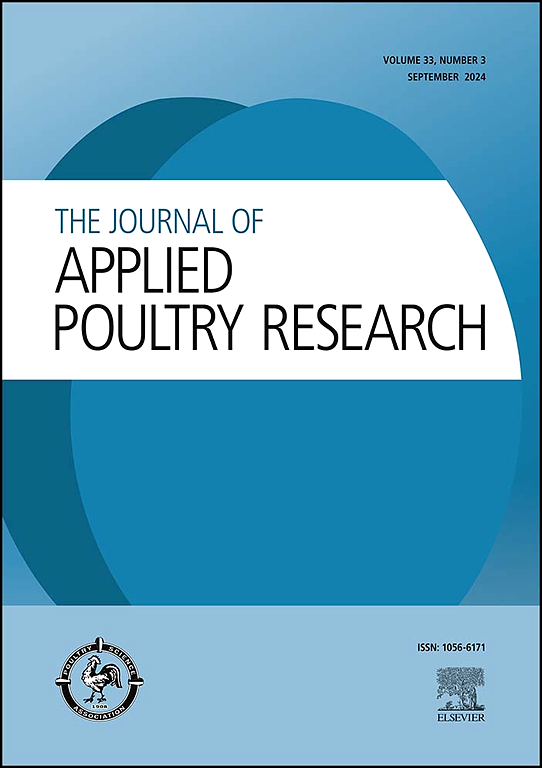A horizontal mixer and a batch-to-horizontal mixer system increased the mix uniformity of free methionine in complete diets relative to a vertical mixer
IF 2
3区 农林科学
Q2 AGRICULTURE, DAIRY & ANIMAL SCIENCE
引用次数: 0
Abstract
The coefficient of variation (CV) of a selected nutrient marker is commonly utilized to measure mix uniformity (MU) of a batch of feed, where a CV < 10 % is considered industry-acceptable. Mixer type and mix time (MTI) have been shown to affect mix uniformity (MU), however, data concerning mixing systems (MSY) are unavailable. Additionally, past research has shown that the selection of an appropriate CV marker is integral in properly evaluating MU. Two experiments were conducted to evaluate a vertical, horizontal, and transfer MSY on MU while utilizing inadequate or adequate MTIs for a corn-salt mixture (CSM) and complete diet (CD). Chloride ion (Cl−) was selected as the marker for the CSM, and crystalline DL-Methionine (Free Met) and crystalline l-Lysine-HCl (Free Lys) were selected as the markers for the CD. Increasing MTI decreased Cl− CV in the CSM (P = 0.020). An interaction between MSY and MTI affected Free Met CV in the CD (P = 0.007). The horizontal and transfer MSYs did not demonstrate changes in the Free Met CV when MTI was manipulated, whereas the vertical MSY provided decreased CV with increased MTI. The authors hypothesize that additional mixing during load-out and conveyance caused this interaction. However, no treatment provided a Free Lys CV < 10 %. These data suggest that Cl− and Free Met are appropriate markers for MU in CSMs and CDs respectively, transfer MSYs may improve the overall efficiency of feed manufacture, and evaluating MSYs as a whole may provide more representative evaluations of feed before animal consumption.
水平混合器和批-水平混合器系统相对于垂直混合器提高了全饲粮中游离蛋氨酸的混合均匀性
所选营养指标的变异系数(CV)通常用来衡量一批饲料的混合均匀性(MU),其中CV <;10%被认为是行业可接受的。混合器类型和混合时间(MTI)已被证明会影响混合均匀性(MU),然而,关于混合系统(MSY)的数据是不可用的。此外,过去的研究表明,选择合适的CV标记对于正确评估MU是不可或缺的。在玉米-盐混合物(CSM)和完全日粮(CD)中使用不充足或不充足的mti时,进行了两项试验,以评估玉米-盐混合物(CSM)和全日粮(CD)在MU上的垂直、水平和转移MSY。选择氯离子(Cl−)作为CSM的标记物,选择结晶dl -蛋氨酸(Free Met)和结晶l-赖氨酸- hcl (Free Lys)作为CD的标记物。增加MTI降低CSM的Cl−CV (P = 0.020)。MSY和MTI之间的交互作用影响CD中游离Met CV (P = 0.007)。当MTI增加时,水平MSY和迁移MSY的Free Met CV没有变化,而垂直MSY的CV随着MTI的增加而降低。作者假设,在装载和输送过程中额外的混合导致了这种相互作用。然而,没有治疗提供免费赖氨酸CV <;10%。这些数据表明,Cl -和Free Met分别是csm和cd中MU的合适标记物,转移MSYs可以提高饲料生产的整体效率,整体评价MSYs可以在动物消费前对饲料进行更具代表性的评价。
本文章由计算机程序翻译,如有差异,请以英文原文为准。
求助全文
约1分钟内获得全文
求助全文
来源期刊

Journal of Applied Poultry Research
农林科学-奶制品与动物科学
CiteScore
4.10
自引率
10.50%
发文量
80
审稿时长
104 days
期刊介绍:
The Journal of Applied Poultry Research (JAPR) publishes original research reports, field reports, and reviews on breeding, hatching, health and disease, layer management, meat bird processing and products, meat bird management, microbiology, food safety, nutrition, environment, sanitation, welfare, and economics. As of January 2020, JAPR will become an Open Access journal with no subscription charges, meaning authors who publish here can make their research immediately, permanently, and freely accessible worldwide while retaining copyright to their work. Papers submitted for publication after October 1, 2019 will be published as Open Access papers.
The readers of JAPR are in education, extension, industry, and government, including research, teaching, administration, veterinary medicine, management, production, quality assurance, product development, and technical services. Nutritionists, breeder flock supervisors, production managers, microbiologists, laboratory personnel, food safety and sanitation managers, poultry processing managers, feed manufacturers, and egg producers use JAPR to keep up with current applied poultry research.
 求助内容:
求助内容: 应助结果提醒方式:
应助结果提醒方式:


